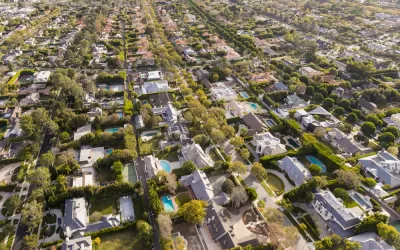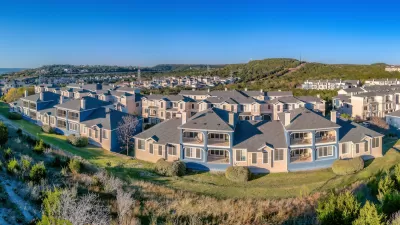Legislation to stop construction of McMansions is being undermined by a zoning loophole.

"In 2008, [Los Angeles] enacted rules designed to crack down on the size of new residences in areas zoned for single-family housing. After the original ordinance was criticized for being too lenient, it was strengthened in 2017, limiting the square footage of homes to 45 percent of a lot’s size," writes Zoie Matthew.
But in the Melrose area of the city, developers are still putting up McMansions, which are driving up home prices and dwarfing surrounding homes. The issue is they are building single-family homes on lots zoned for multifamily buildings.
"In these zones, which were not covered by the original anti-mansionization legislation, developers are allowed to build multiple units—but are not required to build up to the maximum density," says Matthew.
Even with ongoing debates throughout the state about upzoning, city officials and residents want the McMansion construction to stop. "[Councilmember David] Ryu says he plans to introduce legislation in the coming weeks that would expand the baseline mansionization ordinance to multifamily lots, in an attempt to close the loophole," notes Matthew.
FULL STORY: LA cracked down on McMansions. Developers are still building them.

Study: Maui’s Plan to Convert Vacation Rentals to Long-Term Housing Could Cause Nearly $1 Billion Economic Loss
The plan would reduce visitor accommodation by 25,% resulting in 1,900 jobs lost.

North Texas Transit Leaders Tout Benefits of TOD for Growing Region
At a summit focused on transit-oriented development, policymakers discussed how North Texas’ expanded light rail system can serve as a tool for economic growth.

Why Should We Subsidize Public Transportation?
Many public transit agencies face financial stress due to rising costs, declining fare revenue, and declining subsidies. Transit advocates must provide a strong business case for increasing public transit funding.

How to Make US Trains Faster
Changes to boarding platforms and a switch to electric trains could improve U.S. passenger rail service without the added cost of high-speed rail.

Columbia’s Revitalized ‘Loop’ Is a Hub for Local Entrepreneurs
A focus on small businesses is helping a commercial corridor in Columbia, Missouri thrive.

Invasive Insect Threatens Minnesota’s Ash Forests
The Emerald Ash Borer is a rapidly spreading invasive pest threatening Minnesota’s ash trees, and homeowners are encouraged to plant diverse replacement species, avoid moving ash firewood, and monitor for signs of infestation.
Urban Design for Planners 1: Software Tools
This six-course series explores essential urban design concepts using open source software and equips planners with the tools they need to participate fully in the urban design process.
Planning for Universal Design
Learn the tools for implementing Universal Design in planning regulations.
City of Santa Clarita
Ascent Environmental
Institute for Housing and Urban Development Studies (IHS)
City of Grandview
Harvard GSD Executive Education
Toledo-Lucas County Plan Commissions
Salt Lake City
NYU Wagner Graduate School of Public Service




























